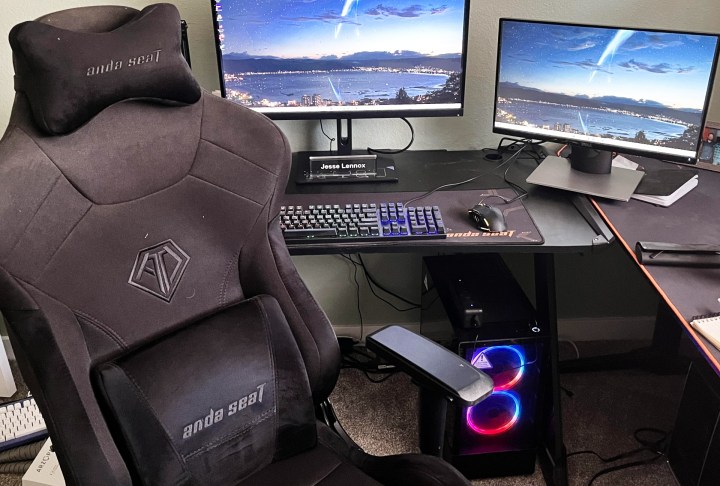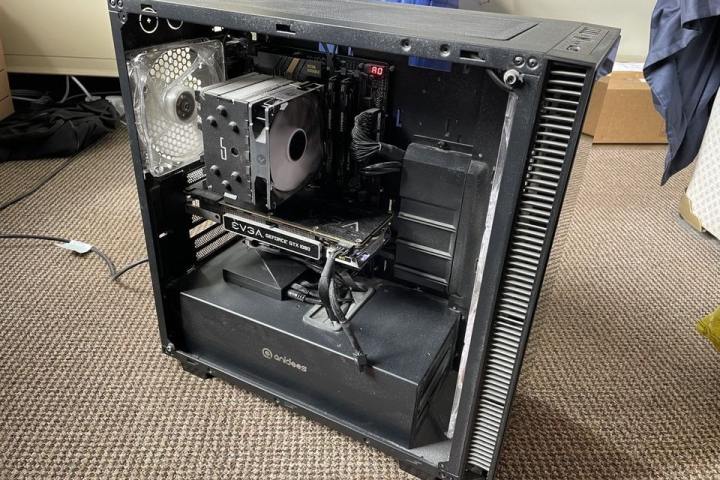
We all have that one PC horror story. Maybe you can laugh about it now, or maybe it’s just a lesson learned, but it probably wasn’t all too funny at the time when everything broke down.
I have plenty of stories like that, but a few of the worst ones that come to mind are all related to prebuilt PCs. Here are some of the prebuilt disasters I’ve seen over the years, and what to look out for if you’re trying to buy a desktop PC.
It’s better to be patient
I’m no custom PC snob, or at least I try not to be, but that doesn’t stop me from warning the people in my life when they decide to buy a prebuilt. This is because buying a good prebuilt PC is not as easy as just walking into a store and picking out the first thing that looks decent enough. Much like PC building, buying prebuilts requires a fair bit of research for things to end well.
When people neglect to do some prior research, the results can be disastrous, causing them to seek help with their broken PC. As the computer geek of the family, I’ve been that “free tech support” person all too many times, and in the case of prebuilts, I sometimes struggled to hold back from saying “I told you so.”
The most recent example is a prebuilt that my mom insisted on buying despite my many offers to build her a PC myself. It wasn’t great to begin with, but, on paper, it was good enough for her limited needs. I set it up with some minor hiccups, such as the non-activated Windows (even though she paid extra for it) and an unresponsive USB port at the front. It wasn’t a spectacular PC, but it worked.
Until it didn’t.

Just a few months later, the PC started running unbearably slowly. As in, it would take over 10 minutes to open up a new tab in Chrome, and rebooting took over 30 minutes from restart until all the startup software was running. Mind you, this was a PC that had an SSD, and it worked well enough up until it suddenly stopped.
Troubleshooting the PC was made harder by the fact that even just running any of the basic monitoring software, such as or CrystalDiskInfo, was next to impossible. Sitting there waiting for the simplest task for over 30 minutes at a time was incredibly frustrating and ineffective.
Knowing my way around cheap prebuilts, I suspected that some of the components might have been refurbished or of poor quality. The main suspect was the SSD. I opened up the PC (which, it turns out, only had a very short warranty), took out the drive, and inserted a different SSD. What do you know — it worked like a charm.
This prebuilt turned out to be quite the flop.
I was able to retrieve all the data from the old SSD by connecting it externally once I got Windows up and running. Out of curiosity, I then ran CrystalDiskInfo on the SSD I took out from the prebuilt, and found out that it had a power on count of well over 1,000. That means that the system had been started up over 1,000 times with that SSD inside it.
There’s no way that thing was new when it was installed in my mom’s “new” prebuilt PC. You don’t power up your PC over 1,000 times in the course of five months.
Needless to say, that prebuilt turned out to be quite the flop. For the price of that PC, I could have built a system with a discrete GPU, not to mention one made out of new parts. Instead, my mom’s stuck with her Ryzen APU and components of dubious quality that might fail at any given time.
This wasn’t the first time when I had to deal with a totally unstable prebuilt, though.
Gaming five minutes at a time

Another horror story takes me back to a friend’s prebuilt that I resuscitated a few years ago. Said friend reached out to me, saying that despite his best efforts at fixing the problem, his PC would shut down almost every time he tried to play games. That description was pretty much everything I needed to hear to narrow it down to two hardware suspects: either the cooler or the power supply.
I checked out the PC myself and, indeed, it turned itself off at random, even when running games that weren’t very demanding and well within what was expected of a PC of that caliber.
It was equipped with a Nvidia GTX 1070 Ti and a pretty old Intel CPU. This is another staple of prebuilts and one of the biggest problems related to them; some sellers will tempt shoppers with recognizable components and then match them with outdated parts. That was the case here. The GPU was a cheaper model, but of the current generation, and the CPU was a few years old.
That PSU really had no business being there.
I ran OCCT to confirm my suspicions. OCCT is a stability/stress-test software that you can use to put your PC through the wringer and see whether it remains stable. Unsurprisingly, the PC crashed in the middle of the test, so I ended up taking it apart and checking out the PSU.
The PSU was made by an unknown brand, but that’s not the biggest problem. It was just too weak to ever handle a rig of this kind, and using a PSU calculator told me that we’d need to buy one that was significantly better. The power supply I found inside was rated at just 400 watts, whereas the GTX 1070 Ti calls for at least a 500W PSU.
Ordering a new PSU and installing it solved the problem, and my friend was able to keep using that PC for a good while. Much like my mom’s PC, the problem wasn’t beyond repair; we just needed to swap out some poorly matched hardware.
However, in cases like this, the PC could have suffered a lot more than it did, seeing as that PSU really had no business being there in the first place. I’m honestly surprised that it kept powering back on against all odds, but that thing was a fighter.
Who needs high frame rates?

Sometimes, problems with prebuilts aren’t as straightforward, and while the computer works, it delivers a miserable gaming experience. That was the case with a prebuilt I dealt with for another friend.
The computer was filled with RGB lighting and the case screamed “gamer,” but when it came to actually playing newer titles, it was miserable. It ran fine otherwise, but if you’d launch a resource-heavy game, it underperformed massively, with huge drops in frames per second (fps).
Anyone who’s ever experienced dips in frame rates knows how frustrating it can be. The game runs fine, you’re starting to get into it, and then, whenever you start a boss encounter or your PC has to render a lot of particularly impressive scenery, boom — the fps tanks.
In the case of this particular computer, it was pretty bad. The fps wasn’t great to begin with, and I certainly expected better based on the components it had, which (if my memory doesn’t fail me) included an Intel Core i9-10900K and an RTX 20-series GPU. It’d max out at around 40 fps to 60 fps in most games, which was quite pitiful for an expensive computer.
Buying and installing a liquid cooler did the trick.
The worst part was that the frame rates would randomly drop down to unplayable levels between 3 fps to 10 fps. They’d bounce back shortly after, but those 10 to 20 seconds of slideshow-like gameplay were enough to make the game nearly unplayable.
In such situations, software issues are something to consider, so we did it all. First, we tried easy fixes such as reinstalling drivers, tweaking in-game settings, checking for malware, and scouring through the Task Manager to see if there were any background processes slowing things down. Nope, nothing.
Running monitoring software (such as HWiNFO) quickly revealed the problem. The PC was overheating massively, and thus, the performance was being throttled. Unlike the previous example, it didn’t shut itself off thanks to those security measures, but it was underperforming by a huge margin.
This ended up being another hardware fix. Buying and installing a liquid cooler did the trick, but in all honesty, the manufacturer should have thought of this beforehand and shipped the PC with, at the very least, a very capable air cooler. Pairing a near $500 CPU with a $20 cooler can never end well.
The above are just some of the horror stories I’ve seen over the years. There’s more, such as a PC that arrived with a poorly installed cooler and a loose GPU that ended up being damaged as it got knocked around the case. I’ve also seen plenty of reliable prebuilts that served their owners well for years, so it’s not all terrible. You just need to know what to avoid.
How to avoid prebuilt PC disasters

I’ve been building my own PCs for over 15 years, but even still, I’ll be the first one to admit that the PC-building community can border on elitism given how much the custom PC narrative is often being pushed. The truth is that some prebuilts are worth both the money and the time.
Some are decidedly not, but that doesn’t mean you should never buy a prebuilt.
When choosing between a prebuilt and a custom PC, consider where you’re shopping from. The best brand is one that lets you know all of the components inside, and preferably doesn’t use proprietary parts. It’s not inherently bad — some big companies also do it — but you’re better off getting a fully upgradeable and repairable PC with components that were made by known brands.
If you’re buying a full prebuilt with limited customization options, make sure to read and watch some reviews before you shop. We have roundups of gaming desktops and desktops for all use cases that we’ve tested ourselves, so start there.
Avoid vague product listings like the plague. It’s not enough that the retailer claims that the PC is equipped with one of Nvidia’s top graphics cards or one of the fastest processors from AMD. If the brand is trustworthy, it’ll have nothing to hide. Ask for benchmarks and make sure that you’re getting a lengthy warranty on the entire PC.
Building a PC by yourself can help you avoid disasters like what I’ve described above, but it requires even more research and the confidence to put it all together by yourself. I’m not going to tell you that you have to do it — it might be the more reliable path toward a good PC, but it’s certainly not the only way to get one. And if building your own PC is too intimidating, you can always buy the parts at a store like Micro Center and pay extra for the assembly.
No matter what you choose to do, do some research before buying, and don’t be afraid to ask questions. Doing this should save you from buying one of those disappointing PCs I described above and instead give you something capable of doing a great job for several years.




